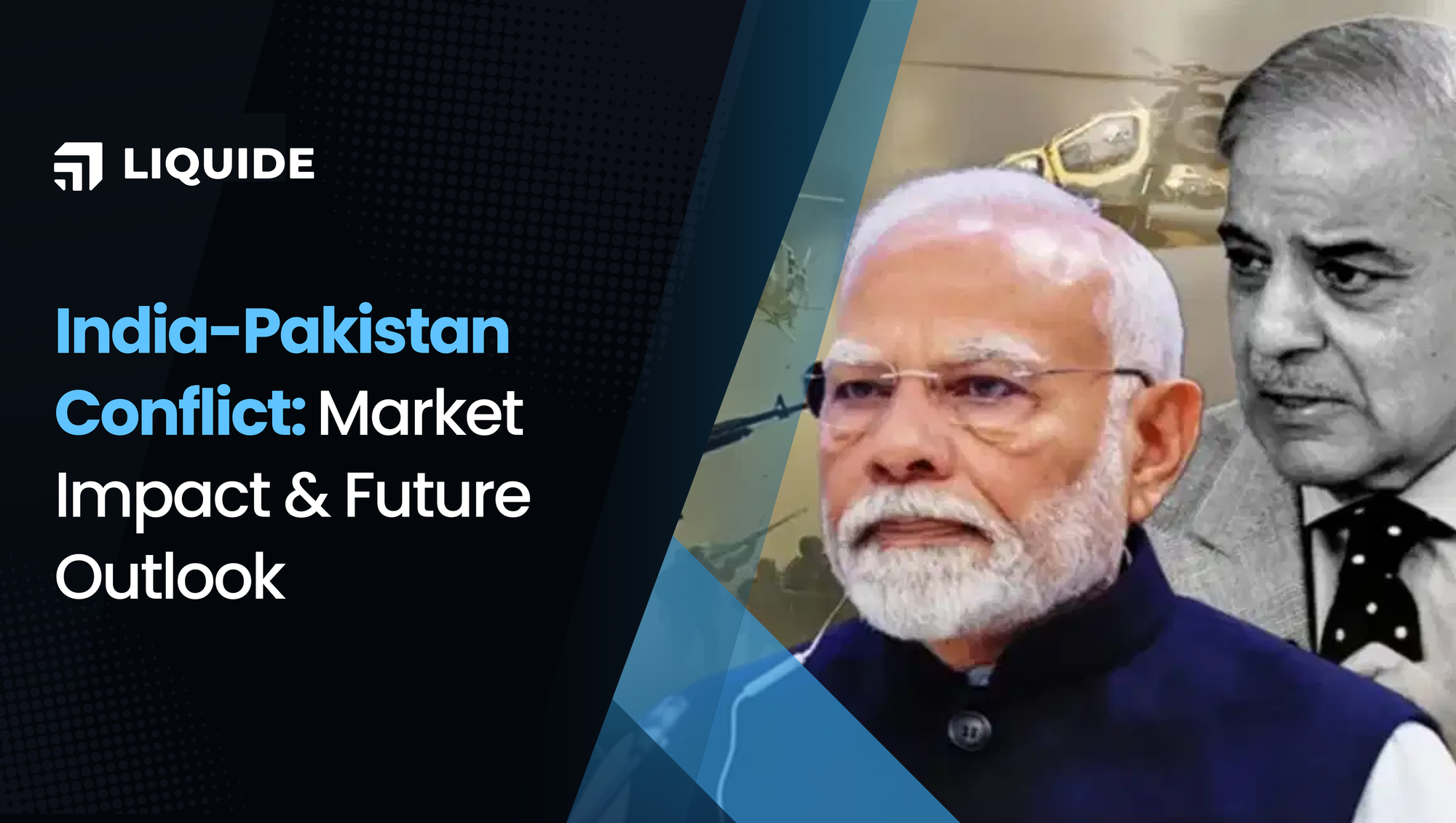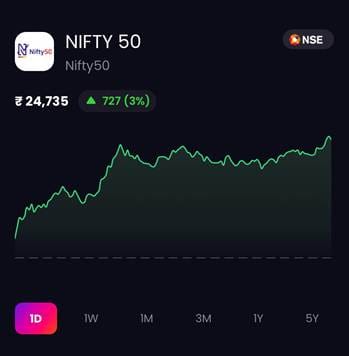War & Markets: A Look at India's Strategic Response & Economic Impact
Explore how the India-Pakistan conflict is affecting markets, from volatile stock indices to economic risks. Learn about India’s strategic response, historical market trends, the positive impact of the India-UK trade deal and key investment opportunities.

Recent geopolitical tensions between India and Pakistan have sent shockwaves through global markets. In response to a terrorist attack in Pahalgam, Kashmir, India targeted terrorist cells in Pakistan, leading to a series of escalations that have weighed heavily on the financial markets.
Let’s explore how these developments are impacting the markets and what investors can expect moving forward.
Market Reactions to Escalating Conflict
Stock Market India | The recent military actions between India and Pakistan resulted in a sharp uptick in market volatility. India Vix, the fear gauge, understandably spiked by 18.5% last week, continuing its upward trend since the Kashmir developments on April 22.
Indian stock indices took a hit, with the benchmark index dropping by 1.4% over the week. Small and mid-cap stocks followed suit, showing the same signs of investor jitters. Despite foreign institutional investors maintaining a net buying position for four weeks straight, the escalating tensions led to some selling on Friday.
As violence escalated, India and Pakistan agreed to halt all military actions on land, air, and sea from 5 pm on Saturday. But just hours later, Pakistan violated the ceasefire, which only added to the market uncertainty. While things stayed tense, the Indian Army reported on Monday that the Line of Control (LoC) and border areas were "largely peaceful" after the ceasefire.
This calm sparked a sharp gap-up opening in Indian markets on Monday. This calm sparked a sharp gap-up opening in Indian markets on Monday. By 11:30 am, the Nifty had risen 3%, reaching 24,735, while the Sensex surged by 2,335 points to 81,790.

Looking ahead, the market’s direction will hinge on how the situation between India and Pakistan unfolds. Further escalation could weigh on markets, while a sustained ceasefire may bring relief and potential recovery.
Historical Context: How the Market Has Responded to Past Conflicts
Let's take a look at how the Indian markets have historically responded to conflicts with Pakistan:
- 1999 Kargil War: Despite a 5% drop in the Sensex in May 1999, the market rebounded with a 20% gain by the end of the year, thanks to the growth of the IT sector.
- 2001 Parliament Attack: In December 2001, the Sensex fell by 7%, but markets stabilized by mid-2002, with the Sensex rebounding by 10%.
- 2008 Mumbai Attacks: After a 4% drop in late November, the Sensex bounced back with an 80% recovery in the following year.
- 2019 Pulwama–Balakot Crisis: The Sensex fell around 2% in February but ended the year 10% higher.
(Source: Moneycontrol)
These historical patterns highlight an important lesson: while short-term volatility is inevitable during times of crisis, the long-term market outlook is often shaped by macroeconomic factors like GDP growth and corporate earnings.
Macroeconomic Impact: Inflation and Fiscal Risks
War often places immense pressure on a nation's economy. Supply chains get disrupted, inflation rises and fiscal deficits widen. Historical data from the Kargil War shows a significant spike in inflation, with the Wholesale Price Index (WPI) jumping from 3.3% to 9.2%. Similarly, the fiscal deficit widened to 5.9% of GDP.
However, despite these challenges, India’s GDP growth remained resilient during past conflicts. Today, India’s economy is in a much stronger position, with an average projected growth rate of 6.3% for FY26.
Given these trends, while the conflict could lead to temporary inflation and fiscal pressures, the risk of prolonged economic damage remains contained, provided the situation does not escalate further.
Positive Developments: India’s Trade Deal with the UK
In more positive news, India recently struck a significant trade deal with the UK. After more than three years of negotiations, India and the UK finally signed a free trade agreement (FTA) that is expected to foster trade, investment, and job creation in both economies.
This deal is a major milestone in the India-UK Comprehensive Strategic Partnership as it will reduce tariffs on 90% of British products sold in India, including whisky, food and electronics. As a result, bilateral trade is expected to grow by $34 billion annually by 2040.
How the UK Trade Deal Impacts India’s Global Standing
In the context of a shifting global trade landscape, particularly with the USA's reciprocal tariffs, the India-UK FTA provides a platform for India to assert its position on the global stage. This deal will enhance India’s bargaining power in future trade negotiations with other global powers like the US and the EU, contributing to its march towards becoming a developed nation.
Conclusion: Market Outlook Amidst Geopolitical Tensions
As the situation between India and Pakistan continues to evolve, market sentiment remains highly sensitive to geopolitical developments. Any clarity (or chaos) from Washington will inevitably affect how emerging markets react.
For investors, it’s important to remember that predicting geopolitical events is impossible. The best approach is to stay informed and prepared. Rather than attempting to time the market, focus on long-term investment strategies.
As geopolitical tensions simmer, we also have Q4 earnings rolling in. The key takeaway here? Focus on businesses with strong fundamentals, clean balance sheets and sustainable growth paths. Stick to your long-term financial goals, avoid panic selling and consider this an opportunity to build a stronger portfolio.
Looking for Investment Opportunities?
Liquide is here to help! With our powerful tools, such as LiMo—an AI-powered co-pilot for stock investing—you can make smarter investment decisions.
Available on both the Google Play Store and Apple App Store, Liquide offers up-to-date market analysis, expert recommendations, and real-time insights to guide your investment journey. Download the Liquide App today and enhance your financial future with our cutting-edge features.

